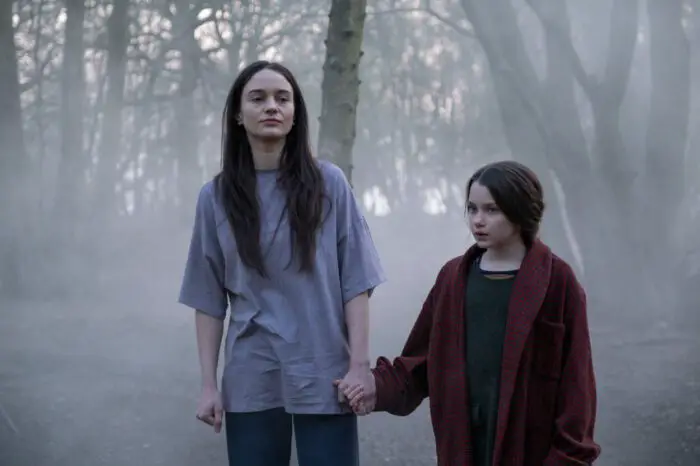Stopmotion is a meditation on the process of creation, and the often destructive mindset of an overthinking artist. Robert Morgan’s new horror is a tight, contained story that leans on a number of interesting ideas, first and foremost its use of actual stop-motion animation. Stopmotion is a live-action film, though, only occasionally employing stop-motion techniques, though it does so to great effect. This, combined with the script co-written by Morgan and Robin King, create a surreal and often disturbing horror film. It is, in more ways than one, a very gutsy film.
Stopmotion stars Aisling Franciosi (The Last Voyage of the Demeter) as Ella, an animator who begins the story seemingly under the shadow of her mother, supposedly a legend in stop-motion animation. Her mother is controlling, overbearing even, and uses guilt as a weapon to keep Ella working for her. She’s aging, on her way out even, and is using Ella as her steady hands to make one last film. Meanwhile, Ella sneaks away to see her boyfriend Tom (Tom York) and his friends, including his sister Polly (Therica Wilson-Read), another animator who works on advertisements. When Ella’s mother becomes bedridden, Ella is left with the one thing she seems to fear more than her mother: freedom. She chooses, then, to set out making her own film, a far more freeing venture than just following her mother’s orders, but also one that comes with its own weight and pressure.
At first, Ella continues working on her mother’s film at their studio, but one day she meets a strange little girl (Caoilinn Springall of The Midnight Sky) venturing the halls who displays a marked curiosity about her work. She begins telling Ella her own story, and as if in a trance, Ella begins animating it. Soon, Ella’s obsessiveness with creating something all her own becomes all the more dangerous, and the little girl’s seemingly innocuous tale becomes all too real.

Stopmotion is mostly a film about artists and their relationship to what they create. In this case, creating is a destructive act, a process that consumes the artist and buries them under the weight of their own expectations. Ella’s newfound freedom after her mother becomes incapacitated is not cause for celebration. Her decision to move on from finishing her mother’s film to making her own is not a triumph. And what of Ella’s relationship with this girl, her macabre story, and the way she herself also orders Ella around?

It’s these dynamics and more that make Stopmotion compelling beyond just the horrors it has in store. It is certainly a bit self-indulgent in that way, but the viewer is not, I think, meant to come out of it idolizing artists as if their self-destructive tendencies are somehow selfless or noble. and, furthermore, the film seems less interested in its subtext than its text. It could, more pessimistically, be seen as a condemnation of the actual process of creation. One might leave the film thinking, with how much it takes out of someone to actually create something that is fundamentally their own, whether it is worth it to do at all. Maybe the will to create is just as depraved as our other, less acceptable desires.
Stopmotion does not pull any punches with its actual scares, though. It is a supremely unsettling film, and unabashedly gross. The fleshy, decaying nature of the stop-motion puppets Ella creates make the film’s actual stop-motion segments feel almost like an excerpt from Phil Tippet’s Mad God in texture and tone. There are even moments when the film blends both live-action and stop-motion techniques to chilling effect.
The film’s body horror is unreserved and, at times, shocking—certainly not for the faint of heart. These are not cheap scares, though. Stopmotion’s gross-ness is always artistic and deliberate, and the film takes care to craft its tension well through potent visuals and excellent sound work that adds to its gut-wrenching moments and creates eerie, prolonged silences that unnerve to no end.
Thankfully, for a film about all the heavy burdens of creating art, Stopmotion is an entirely un-burdensome experience. It comes in at a tight 93 minutes, and is entirely unconcerned with explaining itself. Nothing is wasted in Stopmotion; though it is a story of unraveling, it’s not like it begins with Ella in a perfect situation. From the beginning, Ella lives in an unnerving world, controlled by her mother, and seemingly incapable of controlling herself.
She’s like Rapunzel, trapped and at the mercy of her overbearing mother, seemingly desiring her freedom. The comparison is important; Ella is making her own twisted fairy tale in stop-motion, and the film can’t help but feel like one itself. Its setting in The Barons, an old British public housing block, lends to Stopmotion’s cold, desolate, and industrial mood, not unlike the pseudo-Philadelphia of Eraserhead. There are all sorts of signs, furthermore, that Ella’s world is coming apart at the seams. Is she being haunted, or is it all in her head? This is, again, something Stopmotion is unconcerned with. What’s important is all in front of you, though it might be difficult to look at.



